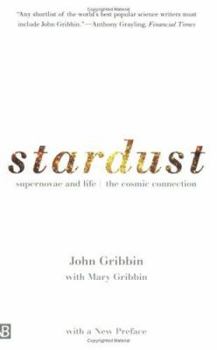Stardust: Supernovae and Life -- The Cosmic Connection
Select Format
Select Condition 
Book Overview
We are made of stardust-and so is all life as we know it. All the chemical elements on earth except hydrogen-including the ones in our bodies-have been processed inside stars, scattered across the universe in great stellar explosions, and recycled to become new stars, planets, and parts of us. In this engrossing book, John and Mary Gribbin relate the developments in twentieth-century astronomy that have led to this shattering realization. They begin...
Format:Paperback
Language:English
ISBN:0300090978
ISBN13:9780300090970
Release Date:September 2001
Publisher:Yale University Press
Length:260 Pages
Weight:0.45 lbs.
Dimensions:0.7" x 5.0" x 7.8"
Customer Reviews
5 ratings
Stardust
Published by Thriftbooks.com User , 14 years ago
Terrific story. Terrific story telling. This book should be required reading for high school graduation. Our society is scientifically illiterate. John Gribbin's writings make a significant contribution to educating the public about the nature of the "world" they live in as well as clarity to the meaning of "scientific theory" versus "belief."
stardust will blow your mind
Published by Thriftbooks.com User , 19 years ago
this book is simply amazing. it charts the evolution of our universe and the elements within it, from the big bang onwards, explaining exactly how stars have evolved and why life exists. easy to read, fascinating, and requiring no background in science, this book should be a standard in schools.
best book of all time
Published by Thriftbooks.com User , 21 years ago
this book will tell you your place in the universe. every human being on the planet should be required to read this book. i have read every word in this book and i highlighted alot of text. i will re-read this book throughout my life. also, read 'river out of eden' by richard dawkins for information on human evolution.
The magic of the stars
Published by Thriftbooks.com User , 22 years ago
Stardust is a magic bok about the cosmic connec tions between the atoms in our bodies and the stars themselves. I rate this John Gribbin's best ever book, and much clearer than Marcus Chown's Magic Furnace. If you only read one science book this year, it has to be this one!
Flawless metaphors and a even a mention of panspermia!
Published by Thriftbooks.com User , 23 years ago
For anyone curious about the sources for the chemical elements of life, this new book has the story. From the manufacture of hydrogen and helium in the big bang, to nucleosynthesis inside stars, to the production of the heaviest elements in supernovae, John Gribbin explains these phenomena in terms any interested person can understand. Often he stands slightly back from the day-to-day story, giving a full panorama that is usually seen only in textbooks. But textbooks never make it as intriguing as Gribbin does. He finds flawless metaphors for many difficult concepts, explains the background carefully, and gives us lots of inside info on the scientists involved. Having studied at Cambridge, he is personally acquainted with many of them. I especially enjoyed learning more about Fred Hoyle's role in the development of the Big Bang theory, his prediction of the carbon-12 resonance, and his contribution to stellar nucleosynthesis theory.In Stardust Gribbin pays needed attention to panspermia -- it is the subject of the first chapter. He fully recognizes the scientific paradigm shift toward panspermia that has already taken place, now that the abundance of organic compounds in space has become established. He even opines, rather than "biological material falling onto a pre-existing planet,... it is much simpler for the material to mingle with the stuff from which planest formed in the first place" (p 15). This idea might mesh with Thomas Gold's theory that there is life very deep below Earth's surface. But in the end, Gribbin sees no need for the stronger versions of panspermia. For example, he writes, "Amino acids, it cannot be stressed enough, are just one step away from living molecules" (p 177). What the heck are "living molecules?" Of course, Gribbin is an astrophysicist, and in this book his focus is on the chemicals of life only. He does not even consider the hard problem of accounting for the genetic programs behind life. If he were to consider it, he might find panspermia to be worthy of another whole book. From a scientists who does such thorough research and writes so well, this would be a welcome prospect!




